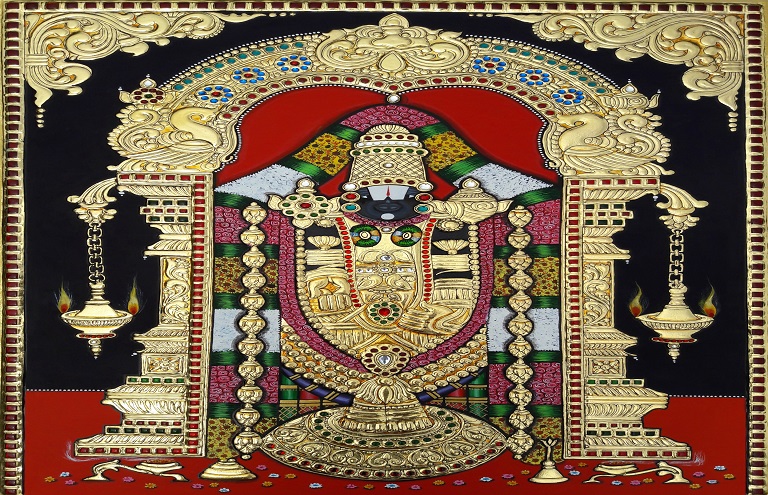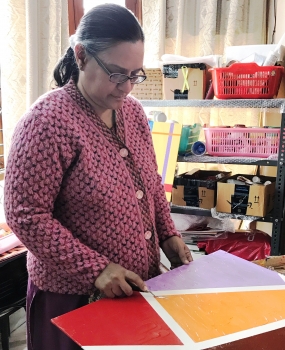
Tanjore Canvas Paintings are a stunning form of Indian art that originated in the town of Tanjore in Tamil Nadu. Known for their vivid colors, intricate details, and lavish use of gold foil and precious stones, these paintings are a testament to India's rich artistic heritage. Combining influences from various regional and cultural traditions, Tanjore Canvas Paintings have become a symbol of India's diverse artistic expressions. In this article, we will explore the history, characteristics, beauty, and significance of Tanjore Canvas Paintings, shedding light on the art form's unique qualities and the reasons for its continued relevance.
History of Tanjore Canvas Paintings
Tanjore Canvas Paintings have a long and rich history that dates back to the early 16th century. The art form was initially developed during the reign of the Nayakas, a dynasty that ruled over the region of Thanjavur.
The paintings were created to adorn the walls of temples and palaces and were often commissioned by the royalty and wealthy merchants of the time. The art form reached its zenith during the Maratha period in the 17th century when Tanjore became a cultural and artistic hub.
Over time, the art form evolved and incorporated influences from other Indian art styles such as Mughal, Rajasthani, and Deccan art. The use of gold foil and precious stones like pearls, rubies, and diamonds became a distinctive feature of Tanjore paintings.
Despite facing decline in the 19th century, Tanjore paintings were revived in the 20th century through the efforts of art connoisseurs and craftsmen who sought to preserve this unique art form. Today, Tanjore paintings continue to be a popular form of traditional Indian art and are appreciated for their aesthetic and cultural value.
Characteristics of Tanjore Canvas Paintings
Tanjore Canvas Paintings are known for their unique characteristics that set them apart from other art forms. Here are some of the key features that define the style:
-
Use of Gold Foil and Precious Stones: One of the most distinctive features of Tanjore paintings is the use of gold foil and precious stones to create a rich and opulent effect. The gold foil is applied in layers to the painting, while the precious stones are used to add sparkle and color.
-
Vivid Colors: Tanjore paintings are known for their use of bright and vibrant colors that are obtained from natural dyes and pigments. The use of colors like red, green, blue, and yellow create a striking contrast against the gold foil and precious stones.
-
Intricate Details: Tanjore paintings are known for their intricate details that are created using a range of techniques like embossing, shading, and highlighting. The use of these techniques creates a sense of depth and texture that gives the painting a three-dimensional effect.
-
Religious Themes: Tanjore paintings often depict religious themes and figures like Hindu gods and goddesses, saints, and mythological scenes. These paintings are meant to inspire devotion and are often used as objects of worship.
-
Traditional Style: Tanjore paintings are created using traditional techniques and styles that have been passed down through generations. The paintings are created on wooden panels that are coated with a layer of lime paste and then polished to create a smooth surface.
Overall, Tanjore Canvas Paintings are a unique art form that combines intricate details, vivid colors, and the use of precious materials to create a sense of opulence and luxury.
Beauty of Tanjore Canvas Paintings
Tanjore Canvas Paintings are a feast for the eyes, with their opulent use of gold foil and precious stones, vivid colors, intricate details, and religious themes. Here are some examples that showcase the beauty of this art form:
-
Krishna with Cow: This Tanjore painting depicts Lord Krishna, one of the most popular deities in Hindu mythology, playing his flute while surrounded by cows. The use of gold foil and precious stones adds a sense of grandeur to the painting, while the bright colors create a sense of joy and playfulness.
-
Saraswathi: This painting depicts the goddess Saraswathi Painting, who is associated with knowledge, wisdom, and the arts. The intricate details of the painting, particularly in the face of the goddess, showcase the skill of the artist. The use of gold foil and precious stones adds a sense of serenity and spirituality to the painting.
-
Raja Ravi Varma: This painting is a modern interpretation of the Tanjore style by the celebrated artist Raja Ravi Varma. The painting depicts a woman with a lotus flower, and the use of bold colors and gold foil adds a sense of drama and vibrancy to the piece.
The beauty of Tanjore Canvas Paintings lies in their intricate details, vivid colors, and the use of precious materials like gold foil and precious stones. These elements create a sense of opulence and luxury that is rare in other art forms. Additionally, the religious themes of the paintings add a spiritual dimension to the art, making it not just visually pleasing but also emotionally evocative. The traditional techniques and styles used to create these paintings add to their beauty, as they showcase the skill and craftsmanship of the artists who have passed down these techniques from generation to generation.
Importance of Tanjore Canvas Paintings
Preserving and promoting Tanjore Canvas Paintings is essential for several reasons. Firstly, the art form is an integral part of the cultural heritage of India, and its preservation is crucial for maintaining the country's rich artistic legacy. Tanjore Canvas Paintings are an example of the fusion of various regional and cultural influences that have shaped the art of India, and their continued existence is a testament to the country's artistic traditions.
Secondly, Tanjore Canvas Paintings are a unique art form that showcases the skill and craftsmanship of the artists who create them. These paintings are created using traditional techniques and materials that require great skill and expertise, and their preservation is necessary to ensure that these techniques are not lost to time.
Furthermore, Tanjore Canvas Paintings play an important role in the religious and spiritual life of many people in India. These paintings are often used as objects of worship and devotion, and their continued existence is crucial for maintaining the cultural and spiritual practices associated with them.
Lastly, Tanjore Canvas Paintings have a significant economic value as they are a popular form of traditional Indian art that is sought after by collectors and art lovers worldwide. Promoting and preserving this art form can contribute to the growth of the art industry in India and provide employment opportunities for artists and craftsmen.
In conclusion, the preservation and promotion of Tanjore Canvas Paintings is important not just for their artistic and cultural value, but also for their economic significance. These paintings are a unique and irreplaceable part of India's cultural heritage, and their continued existence is necessary for maintaining the country's rich artistic traditions.
Conclusion
In conclusion, we reiterate that the beauty of Tanjore Canvas Paintings is worth appreciating and preserving. These paintings are a unique and invaluable part of India's artistic legacy, and their continued existence is essential for maintaining the country's rich cultural heritage. We urge everyone to appreciate the beauty and significance of Tanjore Canvas Paintings and contribute to their preservation and promotion.





















